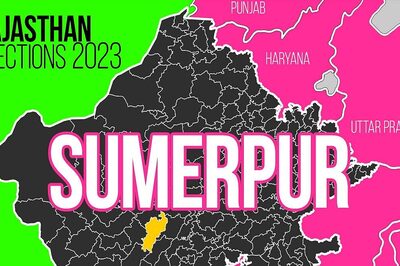
views
AGADEZ, Niger A dispute between Fulani herders and their nomadic Tuareg neighbours over stolen cattle and motorbikes threatened to turn violent in the village of Amataltal when one man grabbed his rifle and fired skywards.
It was a rare outburst in the quiet commune of a few hundred people in north Niger, residents said, and sent a warning: disputes like this have opened a door for jihadists expert at exploiting conflict to boost recruitment and spread chaos.
Wary of escalation, Amataltal’s leaders called in a regional peacekeeping committee to mediate in June last year. Within days, rivals sat opposite each other at tables in a eucalyptus grove. They aired concerns and agreed to keep peace, according to a video of the event and two witnesses.
Islamist violence has overrun large parts of West Africa’s Sahel, the arid region south of the Sahara desert, since 2017 when militants linked to Islamic State ambushed and killed four U.S. soldiers in Niger.
On Sunday, six French aid workers and two locals were shot dead in a giraffe reserve 65 km (40 miles) from Niger’s capital Niamey, in a zone previously considered safe.
But a few hundred miles north, the Agadez region where Amataltal is located – an area the size of France that borders Algeria, Libya and Chad – has remained largely peaceful.
Local leaders say a network of influential ex-rebels, clerics and peace committees – formed in response to an armed uprising seeking greater political autonomy for Tuaregs in the 1990s – has stopped jihadists gaining a foothold by monitoring grievances and people with extreme ideas.
With thousands of French troops struggling to contain the bloodshed elsewhere, and the United States mulling a drawdown of forces, Agadez leaders say their methods offer a possible blueprint for defeating militants – without weapons.
“Agadez shows that it can be done. With the right leadership and the right relationships, you can have stability,” agreed Hannah Armstrong, analyst at the International Crisis Group think tank.
Agadez’s fortunes stand in stark contrast to the Tillaberi region in southwest Niger, which borders Mali and Burkina Faso.
Last year, attacks by militants with links to Islamic State and al Qaeda killed at least 367 people, nearly all in that border zone – four times the number in 2018, according to the Armed Conflict Location & Event Data Project, a U.S.-based research organization. In the first half of 2020, 482 died.
Agadez is not invulnerable: militants exploded a car bomb outside a military base in 2013, killing at least 20 soldiers. In 2010, a local al Qaeda affiliate kidnapped seven foreigners in the region’s uranium mining zone around the town of Arlit.
Similar peacekeeping efforts elsewhere in the Sahel – including Mali before Tuareg rebels took over the north and began advancing on the capital in 2012 – have shown signs of promise before falling apart. A French-led intervention pushed the rebels back the following year, but Islamist militants have since regained a foothold in the north and centre, tapping into rivalries between Tuaregs and Fulanis.
A TALE OF TWO REGIONS
For now, though, Agadez leaders are confident.
“The jihadists are far from here. They are not here because we are paying attention,” said Silymane Hiyan Hiyar, an ex-rebel who spent years living in mountain caves fighting government forces during the 1990s uprising.
He is now a member of the peace committee that visited Amataltal and lives in a compound with his family in the regional capital Agadez, where he spoke to Reuters.
A peace agreement reached in 1995 gave communities in northern Niger a voice by integrating Tuareg rebels into the army and promoting Tuareg politicians.
Ex-rebels are members of peace committees and keep the government informed of disputes. Religious leaders travel in caravans, preaching peace on the government’s behalf.
The changes have not brought continuous peace to Agadez – another Tuareg uprising broke out in the north from 2007-2009 – but experts say the region learned from past struggles.
“The people have seen atrocities in Agadez. Now, as soon as there is conflict, the people come together to discuss the problem,” said Issouf Sibi-Moussa, assistant coordinator at HED Tamat, a local aid group.
In the Tillaberi region, a lack of local leadership, peace mechanisms or strong ties with Niamey have allowed ethnic rivalries to fester and attacks to continue, security experts said. Jihadist groups have won recruits among disaffected locals who believe the state has abandoned them.
“It is dangerous for local officials in Tillaberi to liaise with the state because the jihadists’ intelligence networks are very sophisticated. Their calls and meetings are listened to,” said Armstrong.
Nowhere is this more apparent than in the border commune of Inates, where militants killed over 70 soldiers in an attack on a camp in December. Much of the surrounding area is in the hands of jihadists. Many residents fled.
Algateig Mohamed was driving with the local chief to a neighbouring town in July last year when gunmen on motorcycles encircled their car and opened fire, he said.
The assailants tied his hands behind his back and knocked him unconscious with a rifle butt, he said. He woke alone and walked all night to get home. When he arrived, he found out the chief was dead.
Mohamed fled the next day with his wife and six children.
“There is death there,” said Mohamed, who sleeps on the unswept floor of a friend’s house in Niamey. “I cannot go back.”
Disclaimer: This post has been auto-published from an agency feed without any modifications to the text and has not been reviewed by an editor




















Comments
0 comment